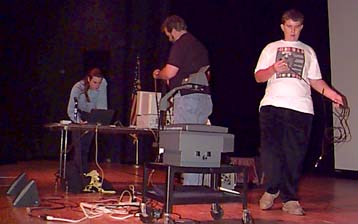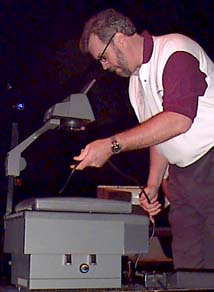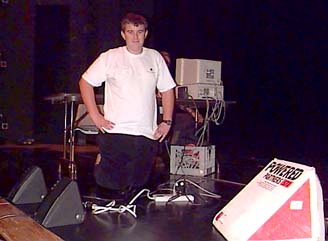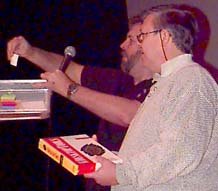



Each month (except June and December) Washington Apple Pi puts on a General Meeting. In many ways, a General Meeting is much like a rock concert, except it is usually quieter, people are generally older (and sober), and it takes place early in the morning rather than late in the evening. Aside from this, however, they’re almost identical.
 |
|
The roadies in full bloom: unboxing, setting up, stringing cables. |
The "roadies" arrive first, bringing in equipment, magazines, brochures, boxes of diskettes, and whatever else is required. Finding and opening the meeting space is a high priority: over the years, Washington Apple Pi has held general meetings in people’s homes, schools, federal buildings, hotels, and colleges. In just the past few years, the advance party has arrived to find the meeting site locked, or without chairs, or in various stages of unreadiness. Once, I was stopped by a very suspicious security guard, determined to find out how I had entered a locked auditorium. I finally managed to suggest that maybe it wasn’t locked (it was), that I hadn’t been sneaking in (I had), and that a thief would not be taking valuable computer equipment into a locked room (fortunately, he didn’t think to ask how valuable a Macintosh IIci might be).
 |
|
Don Essick, the Pi's Vice President for Macintosh programs, sets up a Proxima active-matrix LCD panel. The LCD panel, combined with a bright overhead projector, blasts out a large-screen version of whatever is being demonstrated at the General Meeting. During the course of a year, it isn't unusual to work with half a dozen different projection systems. Setting these up with an audience of early risers watching your every move is a challenge. Even for gadget lovers. |
Once the meeting site is secured, the "roadies" divide into two sections: one group assembles the famed "Pi table," usually several conference tables stacked with brochures, magazines, diskettes, mugs, sample CD-ROMs, sample magazines, various advertisements, and a cash register for handling membership sales and other transactions. A separate group sets up the equipment for the presentations.
 |
|
David Essick checks out electrical cables and the Pi's amplified speakers (the black wedges on the left). In all honesty, David was really stopping to ask, "Is that a digital camera?" just moments before the flash went off, after which he screamed, "My eyes! My eyes!" |
In the beginning, Pi presentations were quite simple: someone would bring in their Apple II and, with everyone else crowding around, then wow the crowd with an AppleSoft BASIC program that draws multi-colored sine waves. But that was twenty years ago; today, a Pi presentation has (1) a projection system, ideally bright enough to fill a bus-sized screen with a crisp image of (2) whatever was appearing on the presentation machine, usually the Pi’s Power Macintosh 7100 or a visiting PowerBook or Power Macintosh brought in by the vendor, with (3) stereo sound blasted out to the audience via a pair of amplified speakers. As the Pi doesn’t own a projection system, it is always fun trying to figure out how the projector of the day works, or how it doesn’t work. Extra entertainment is supplied if additional hard drives, cameras, joysticks, or other peripherals are required. In one memorable case, a huge vacant hotel room without tables, chairs or a projector was transformed into a multi-media presentation site, right in time for the start of the meeting &endash; missing only the vendor’s representative, trapped in a cab with a driver who’d never heard of Bethesda, Maryland. This was a problem: Bethesda was the meeting site that month.
|
|
|
Apple Computer brought two machines to the November 1997 General Meeting, a Power Macintosh 8500 for demonstrating Rhapsody (shorter tower on the left) and a new Power Macintosh G3 mini-tower for demonstrating high-speed computing (the taller tower on the right). Sitting atop the G3 is an APS external hard disk drive. From the front, it all appears sane and orderly. |
|
|
|
From the back, the two machines are a maze of cables and cords. Things get really entertaining if a cable or cord is missing; there have been meetings where only a cable, cord, keyboard, terminator or some other gizmo borrowed from someone in the audience saved the day. You would be astonished at what people will carry to a 9 a.m. meeting. |
The General Meeting almost always starts off with a Question and Answer session at 9 a.m., and many people come early just to participate in the Q&A session. But just as many, it seems, come even earlier so they can watch people frantically plug in cables, string electrical cords, and ask deep questions of the equipment. "Why won’t you fit?" is the most popular question, asked of a keyboard cable that refuses to plug into a serial port, or of a three-prong power cable that objects to a two-prong extension cord, or of two seemingly identical RCA jacks on the ends of two video cables, only one of which works with an NTSC video converter. (Early Apple II folks understood NTSC video and RCA jacks, as the early Apple II computers worked with television sets. But to Mac users, NTSC, RCA and similar terms are Deep and Imponderable Mysteries.)
 |
|
Tom Witte (foreground) and Don Essick select winners at the end of a General Meeting. Most drawing prizes are donated by visiting vendors, but "prize loot" is also donated by other vendors eager to get a bit of publicity. Both Tom and Don are far-sighted, and there is always an air of mystery and suspense as they struggle to read the handwriting of the winners. |
The accompanying pictures may give some idea of what goes into this monthly madness. Taken with a Kodak DC50 digital camera, they may print too dark to see much, if any, detail (a problem when taking pictures in a large, darkened auditorium). If they are, in fact, unrecognizable, then you’ll just have to take our word for it that these are from the October and November 1997 General Meetings, and not satellite photos of the Loch Ness monster.
![]()
Revised Saturday, August 28, 1998 Lawrence I.
Charters
Washington Apple Pi
URL: http://www.wap.org/journal/